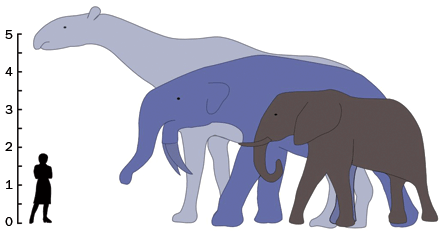After dinosaurs went extinct 65 million years ago, land mammals tended to supersize and then hit a limit, roughly at the same time worldwide.

“Globally, there is a really clean pattern that shows up,” says paleoecologist Felisa A. Smith of the University of New Mexico in Albuquerque. In the broadest survey yet of big-mammal body size, she and colleagues found that mammal groups around the world tended to give rise to giant species at about the same time. The largest, for example, the hornless rhinoceros-like Indricotherium transouralicum, would have weighed about seventeen tons.
Such supersizing took only about 20 million years, she and her colleagues note.
But by about 40 million years ago, the trend slowed and sizes reached a plateau, the researchers report in the Nov. 26 Science.
“Understanding body size is really critical to understanding anything about an animal,” Smith says. “If you give me an animal and tell me how big it is, I can predict its metabolic rate; I can predict its fecundity.” Even blood circulation, kidney function and what an animal eats relate to body size, she says.
Smith and her colleagues looked for the largest known species in 32 broad groups, or orders, of mammals at various times since the dinosaurs’ demise. Focusing on the biggest species reflected trends in overall size evolution, she says, and had the practical advantage of being readily available in scientific literature. “People like to report the biggest thing,” she says.
The few mammal species that survived the catastrophe that wiped out dinosaurs started small, “about the size of a baseball, certainly not as big as a football,” Smith says.
But with dinosaurs gone, mammal groups diversified to fill new niches, and sizes shot up. Researchers had seen hints in earlier studies of a concerted size boom across continents at that time. Even in far-flung places, “carnivores were the same median size and had the same range of body sizes, which is really weird since they were very different species,” Smith says.
Smith and colleagues include more animals over a longer period of time than earlier studies and find the same trend. Body size correlates roughly with the amount of land area available at the time and with temperature, the researchers say. Those factors therefore may be the major constraints that set a maximum body size.
“The authors are certainly right that maximum body size evolved up to a limit and stayed there,” says John Alroy of Macquarie University in Sydney, who has studied body size trends in North American mammals. He does, however, raise concerns about their statistical methods and how well the researchers adjusted for possible confounding effects in the records they used. For example, he says, in testing for environmental limits to size the researchers “found matches between curves simply because they all trended upwards, but that doesn’t mean anything because the wiggles don’t match up.”
Such methodological questions are indeed issues in paleontology, Smith says, but she contends that they would not affect the big picture of the results.






